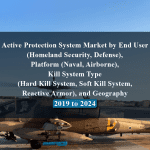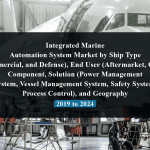OVERVIEW
The Military Communications Market is currently valued at USD 24.5 billion in 2024 and will be growing at a CAGR of 7.9% over the forecast period to reach an estimated USD 35.4 billion in revenue in 2029. The military communications market encompasses a diverse range of technologies and systems tailored to meet the unique demands of modern armed forces. From secure voice and data transmission to satellite networks and battlefield communication systems, this sector is integral to ensuring effective command, control, and coordination across military operations. With an increasing emphasis on interoperability, cybersecurity, and resilience, the market is witnessing rapid advancements in areas such as software-defined radios, tactical communication systems, and unmanned aerial vehicles for surveillance and reconnaissance. As defense organizations worldwide continue to prioritize communication capabilities that are robust, flexible, and adaptable to dynamic operational environments, the military communications market remains a pivotal driver of innovation and strategic advantage.
The rising need for enhanced situational awareness and real-time information sharing on the battlefield is propelling investments in advanced communication technologies. Additionally, the increasing complexity of modern military operations, including joint and multinational missions, necessitates interoperable communication systems that can seamlessly integrate with diverse platforms and networks. Moreover, the growing threat of cyberattacks underscores the importance of secure and resilient communication infrastructures, driving demand for advanced encryption and cybersecurity solutions. Furthermore, the proliferation of unmanned systems and autonomous vehicles is fueling the development of communication systems optimized for remote control and data transmission. Lastly, geopolitical tensions and evolving security threats are prompting governments to modernize their defense communication capabilities, fostering a favorable market environment for innovation and investment in military communications technologies.
Table of Content
Market Dynamics
Drivers:
The rising need for enhanced situational awareness and real-time information sharing on the battlefield is propelling investments in advanced communication technologies. Additionally, the increasing complexity of modern military operations, including joint and multinational missions, necessitates interoperable communication systems that can seamlessly integrate with diverse platforms and networks. Moreover, the growing threat of cyberattacks underscores the importance of secure and resilient communication infrastructures, driving demand for advanced encryption and cybersecurity solutions. Furthermore, the proliferation of unmanned systems and autonomous vehicles is fueling the development of communication systems optimized for remote control and data transmission. Lastly, geopolitical tensions and evolving security threats are prompting governments to modernize their defense communication capabilities, fostering a favorable market environment for innovation and investment in military communications technologies.
Key Opportunities :
The military communications market presents several key opportunities for industry players and stakeholders. One significant opportunity lies in the advancement of next-generation communication technologies, including software-defined radios, cognitive radio systems, and mesh networking solutions, to address the evolving needs of modern warfare. Additionally, the growing demand for secure and resilient communication networks in contested and degraded environments offers opportunities for the development of robust encryption, anti-jamming, and anti-spoofing capabilities. Moreover, the integration of artificial intelligence and machine learning algorithms into communication systems enables enhanced decision-making, predictive analytics, and autonomous operation, opening avenues for innovation and efficiency gains. Furthermore, the increasing convergence of civilian and military communication technologies, such as 5G networks and satellite constellations, presents opportunities for cross-sector collaboration and leveraging commercial off-the-shelf solutions to meet military requirements cost-effectively. Lastly, the expanding market for unmanned systems, including drones and autonomous vehicles, creates opportunities for the development of communication systems optimized for command and control, data sharing, and remote sensing applications, driving growth and diversification within the military communications market.
Restraints :
One primary challenge is the increasing complexity and cost associated with developing and maintaining advanced communication systems that meet stringent military requirements for security, reliability, and interoperability. Additionally, stringent regulatory frameworks and export controls can hinder international collaboration and limit market access for companies operating in the defense communication sector. Moreover, budget constraints and fiscal austerity measures in many defense organizations worldwide may lead to reduced investment in communication infrastructure and technology upgrades, constraining market growth. Furthermore, the rapid pace of technological change and the emergence of disruptive innovations pose challenges for incumbent suppliers, requiring continuous investment in research and development to remain competitive. Lastly, geopolitical uncertainties, trade disputes, and shifting defense priorities can introduce volatility and uncertainty into the market, affecting investment decisions and project timelines.
Regional Information:
• In North America, the military communications market is driven by robust defense spending, technological innovation, and a strong focus on maintaining superiority in information warfare capabilities. The United States, with its large defense budget and advanced defense industry, dominates the region, accounting for a significant share of procurement and development activities. The demand for secure and resilient communication systems is particularly high, given the country’s global military commitments and its emphasis on network-centric warfare. Additionally, partnerships with key allies and NATO members further bolster collaboration and interoperability efforts, driving demand for standardized communication solutions.
• In Europe, the military communications market is shaped by evolving security threats, including cyber warfare and hybrid warfare tactics, prompting increased investment in command and control capabilities and secure communication networks. With NATO’s renewed focus on collective defense and interoperability, there is a growing emphasis on modernizing communication infrastructure and enhancing information sharing among member states. Moreover, initiatives such as the European Defence Fund and the European Defence Industrial Development Programme aim to foster collaboration and innovation in defense technology, creating opportunities for companies across the region.
• In the Asia-Pacific region, rising geopolitical tensions and territorial disputes drive investments in military modernization and communication capabilities. Countries such as China, India, and Japan are expanding their defense budgets to develop indigenous communication systems and enhance interoperability with key allies. Additionally, the proliferation of unmanned systems and the integration of artificial intelligence into military communications are emerging trends shaping the market landscape in the region.
Recent Developments:
• In August 2023, Ukraine announced that Rheinmetall will supply Ukraine with new Luna NG (next generation) reconnaissance unmanned aircraft systems (UASs). This provision is a segment of a USD 765 million military assistance package committed by the German government for Ukraine, as announced at the NATO summit in Vilnius, Lithuania.
• In May 2023, L3Harris Technologies has disclosed contracts amounting to USD 160 million from the Marine Corps, encompassing multi-channel handheld and vehicular radio systems. This development raises the cumulative program orders to USD 336 million. All U.S. military branches, Special Operations Command, and many key allies have widely embraced the Falcon IV radio family’s software-defined framework. This offers adaptability for ongoing updates and effortless incorporation of new technologies for future requirements.
Key Market Players:
Lockheed Martin, Raytheon Technologies, Northrop Grumman, Thales Group, BAE Systems plc, General Dynamics, L3Harris Technologies, Harris Corporation (now part of L3Harris Technologies), Airbus SE, and Boeing Company.
Frequently Asked Questions
1) What is the projected market value of the Military Communications Market ?
– The Military Communications Market is expected to reach an estimated value of USD 35.4 billion in revenue by 2029.
2) What is the estimated CAGR of the Military Communications Market over the 2024 to 2029 forecast period?
– The CAGR is estimated to be 7.9% for the Military Communications Market over the 2024 to 2029.
3) Who are the key players in the Military Communications Market ?
– Lockheed Martin, Raytheon Technologies, Northrop Grumman, Thales Group, BAE Systems plc, General Dynamics, L3Harris Technologies, Harris Corporation (now part of L3Harris Technologies), Airbus SE, and Boeing Company.
4) What are the drivers for the Military Communications Market ?
– The need for situational awareness, real-time information sharing, and interoperable communication systems in modern military operations is driving investments in advanced technologies. Cyberattacks, unmanned systems, and geopolitical tensions are driving demand for secure infrastructures, while governments are modernizing defense communication capabilities to foster innovation and investment in military communications technologies.
5) What are the restraints and challenges in the Military Communications Market ?
– The military communications market faces challenges such as increasing complexity, cost, regulatory frameworks, budget constraints, rapid technological change, and geopolitical uncertainties. These factors can limit market access, hinder international collaboration, and reduce investment in communication infrastructure. To sustain growth and competitiveness, strategic foresight, innovation, and adaptability are crucial, requiring strategic foresight and adaptability.
6) What are the key applications and offerings of the Military Communications Market ?
– Key applications of military communications include secure voice and data transmission, command and control systems, battlefield communication networks, and satellite communication for remote operations and global connectivity. These systems enable real-time situational awareness, coordinated tactical operations, information sharing among deployed forces, and reliable communication in challenging environments, enhancing operational effectiveness and mission success across land, sea, air, and space domains.
7) Which region is expected to drive the market for the forecast period?
– North America is expected to have the highest market growth from 2024 to 2029
Why Choose Us?
Insights into Market Trends: Global Market Studies reports provide valuable insights into market trends, including market size, segmentation, growth drivers, and market dynamics. This information helps clients make strategic decisions, such as product development, market positioning, and marketing strategies.
Competitor Analysis: Our reports provide detailed information about competitors, including their market share, product offerings, pricing, and competitive strategies. This data can be used to inform competitive strategies and to identify opportunities for growth and expansion.
Industry Forecasts: Our reports provide industry forecasts, which will inform your business strategies, such as investment decisions, production planning, and workforce planning. These forecasts can help you to prepare for future trends and to take advantage of growth opportunities.
Access to Industry Experts: Our solutions include contributions from industry experts, including analysts, consultants, and subject matter experts. This access to expert insights can be valuable for you to understand the market.
Time and Cost Savings: Our team at Global Market Studies can save you time and reduce the cost of conducting market research by providing comprehensive and up-to-date information in a single report, avoiding the need for additional market research efforts.












